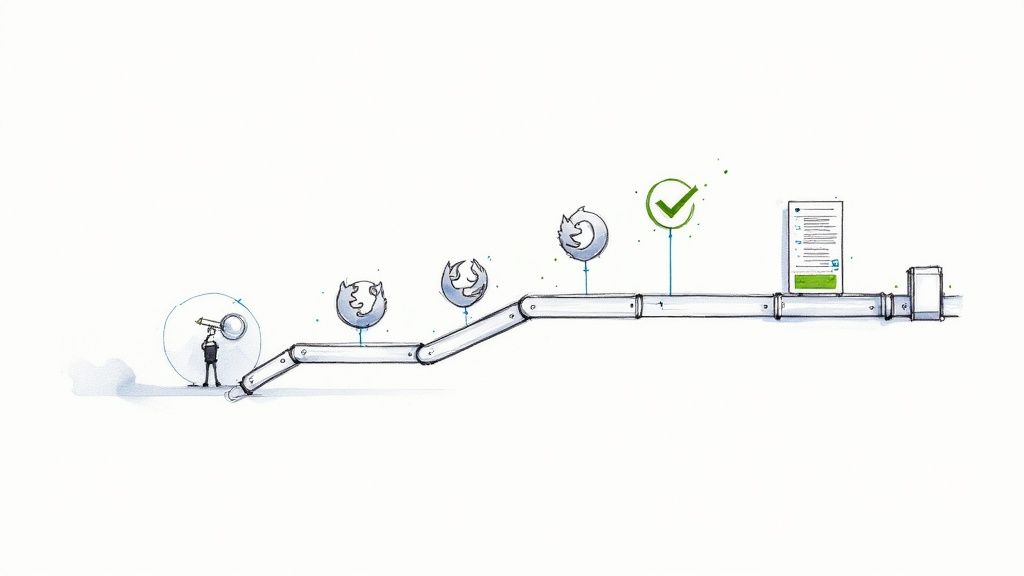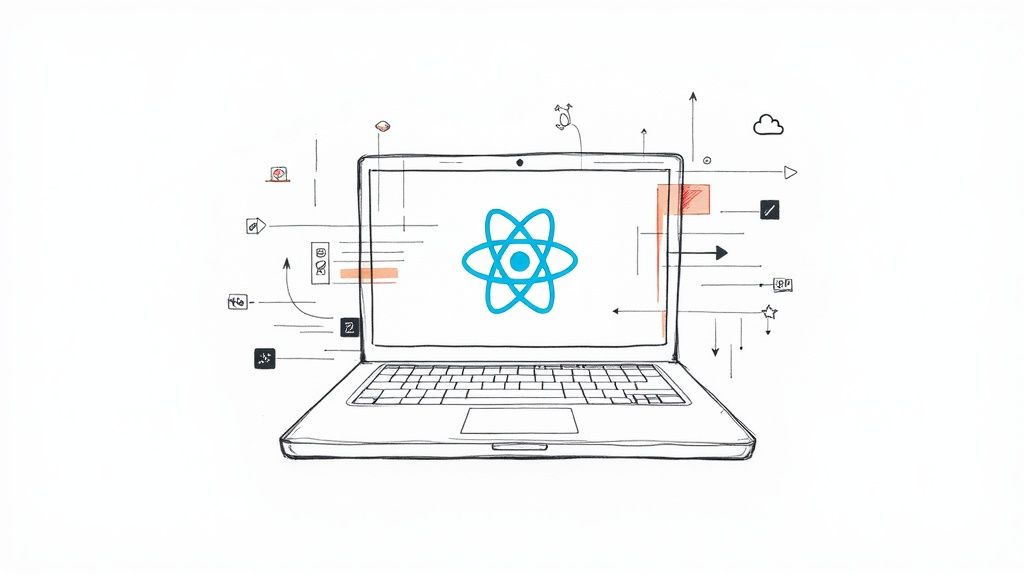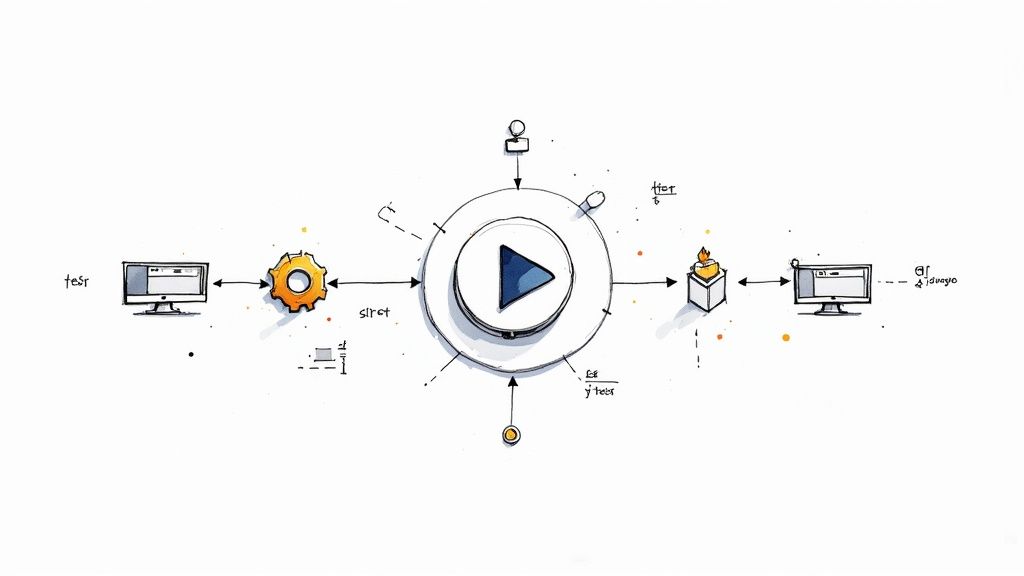Pull Request Best Practices: A Complete Guide for Modern Developers

The Art of Creating Small, Focused Pull Requests
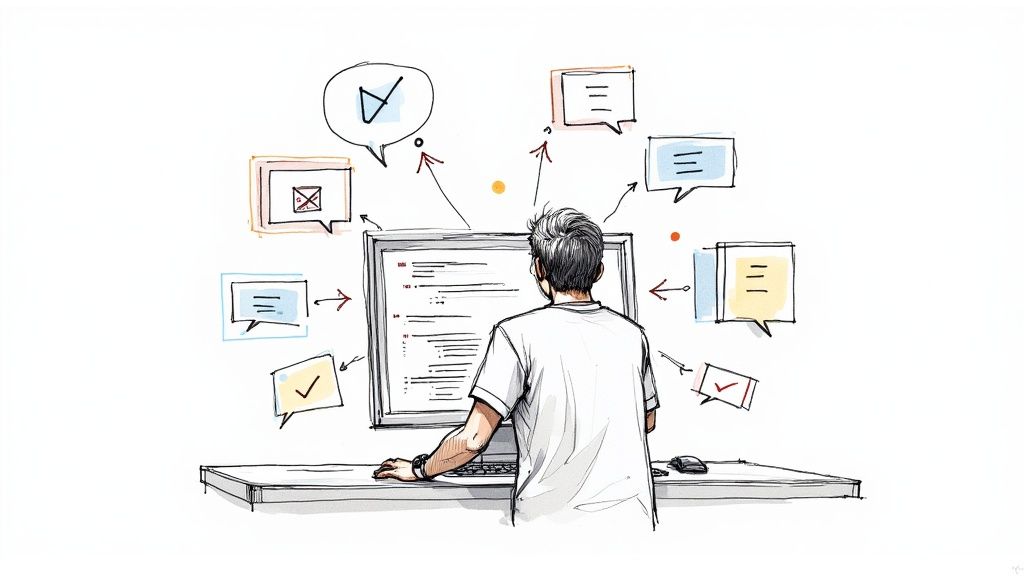
Getting pull requests (PRs) right is a key skill for any developer. It's often challenging to break down complex changes into clear, reviewable pieces. Yet mastering this skill leads to better code quality and smoother team collaboration. Let's explore how to craft PRs that make reviewing code a pleasure rather than a chore.
Why Small Pull Requests Matter
Think of code reviews like proofreading - it's much easier to catch errors in a short paragraph than an entire book. Small PRs bring this same benefit to code review. They enable quick feedback, make bugs easier to spot, and help teams move faster. When something goes wrong, rolling back a small change is simple compared to untangling a massive PR with interconnected changes.
Research backs this up. Teams that keep PRs to around 50 lines of code ship 40% more code than those who regularly exceed 200 lines. Smaller PRs make it easier to write good tests, fix problems, and do thorough reviews. They prevent the bottlenecks and delays that often plague large PRs. For more details, check out Pull Request Best Practices.
Practical Strategies for Sizing Your Pull Requests
Here's how to keep your PRs focused and manageable:
- Single Responsibility Principle: Each PR should do one thing well - fix one bug, add one feature, or improve one area of code.
- Break Down Large Features: Split big changes into smaller, logical pieces that can be reviewed separately.
- Modular Design: Write code in small, independent units that can be changed without affecting other parts.
- Iterative Development: Build features step by step, getting feedback along the way instead of doing everything at once.
Avoiding Feature Creep
It's tempting to keep adding "just one more thing" to a PR. But this leads to bloated changes that are hard to review and likely to introduce bugs. Small, focused PRs create natural boundaries that prevent scope creep. Teams can track progress better and ship features reliably when each PR has clear limits. Tools like Mergify can help enforce size limits and merge rules, keeping PRs on track.
By making small, focused PRs a habit, teams build a foundation for effective code review and delivery. In the next section, we'll look at how to measure whether your PR process is working well.
Measuring What Matters: Key Metrics for PR Success
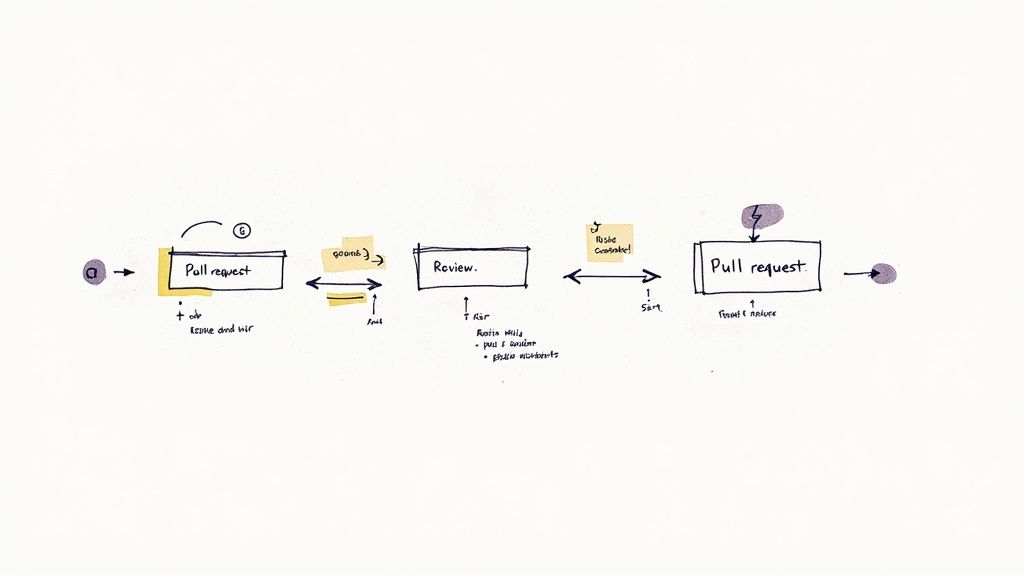
To get real value from pull requests (PRs), teams need to look beyond basic counting and focus on metrics that reveal true impact. Good PR management comes down to tracking specific measures that show how well your team collaborates, maintains code quality, and keeps work flowing smoothly. Let's explore the key numbers that can help your team succeed with PRs.
Key Metrics to Track
These core measurements give you clear insight into your PR process:
- PR Size: Counting changed lines of code shows how complex each PR is. Smaller PRs typically get reviewed faster and have fewer bugs.
- Review Cycle Time: The total time from creating to merging a PR. Getting this number down often points to better efficiency.
- Review Cycles: How many times reviewers and authors go back and forth. Fewer cycles usually means clearer communication.
- Number of Reviewers: The count of team members reviewing each PR. Finding the right balance is key - too few might miss issues, too many can slow things down.
- Number of Comments per PR: Shows how much discussion each PR generates. More comments could mean the changes need more clarification.
Setting Up Tracking That Works
Getting PR tracking right starts with picking good tools and having clear goals in mind. Mergify can help by automating parts of your workflow, like setting size limits and assigning reviewers. By connecting these tools to your project management system, you can spot bottlenecks and track overall progress better.
Looking at PR statistics helps teams understand how well they're working together and maintaining code quality. Key numbers to watch include how many PRs get created, merged and declined, plus how these numbers relate to each other. For example, if many PRs get merged without review, that could signal a problem. Tracking code changes helps catch risks from big, complex PRs. Usually, faster PR cycles mean smoother development, though there can be exceptions. Find more stats details here.
Making Sense of the Data
After setting up tracking, you need to understand what the numbers tell you. If PRs consistently need many review cycles, your team might need better documentation or communication. Long review times could mean you need more reviewers or your PRs are too big. Use these insights to make specific improvements.
Always Getting Better
Your PR process should grow and change just like your code does. Keep checking how your metrics and processes work, and adjust them to fit your team's changing needs. When you focus on tracking what really matters, you can write better code faster and help your team work together more effectively.
Finding the Sweet Spot: Optimal PR Size and Scope

Code reviews work best when pull requests (PRs) are sized just right. Too large, and reviewers get overwhelmed. Too small, and the development process slows down. Finding that balance helps teams work efficiently while maintaining high code quality standards.
The One-Hour Review Rule
Research shows that smaller PRs lead to better outcomes. A SmartBear study analyzing 2,500 pull requests across 10 months found that smaller PRs had fewer defects (read the full study). This research points to a practical guideline: aim for PRs that take about one hour to review. This makes more sense than just counting lines of code, since some changes might be lengthy but straightforward to review. For example, renaming a variable across many files could affect hundreds of lines while being simple to verify.
Context Matters: Adapting PR Size
While one hour is a good target, the right size depends on what you're working on. A quick bug fix naturally needs less code than adding a major feature. Teams should stay flexible and adjust PR sizes based on their specific needs.
Strategies for Right-Sizing Your PRs
Here's how to determine appropriate PR scope:
- Consider the complexity: Complex changes need more review time, even if they're small
- Factor in team dynamics: Some teams work better with frequent small PRs, others prefer larger batches
- Prioritize clarity: Include clear descriptions and commit messages to help reviewers understand your changes quickly
Breaking Down Large Changes
When working on big features or major refactoring, splitting the work into smaller PRs helps everyone. This takes planning to avoid creating disconnected, hard-to-review changes.
Try these approaches to break down large changes:
- Identify independent units of work: Group related changes that can stand alone
- Use feature flags: Hide incomplete features behind flags so you can merge smaller PRs without affecting users
- Establish a clear branching strategy: Organize your branches to show how changes build on each other. Mergify's merge queues can help manage these complex scenarios.
Following these guidelines helps teams review code more effectively and ship better software faster.
Mastering the Art of Effective Code Reviews
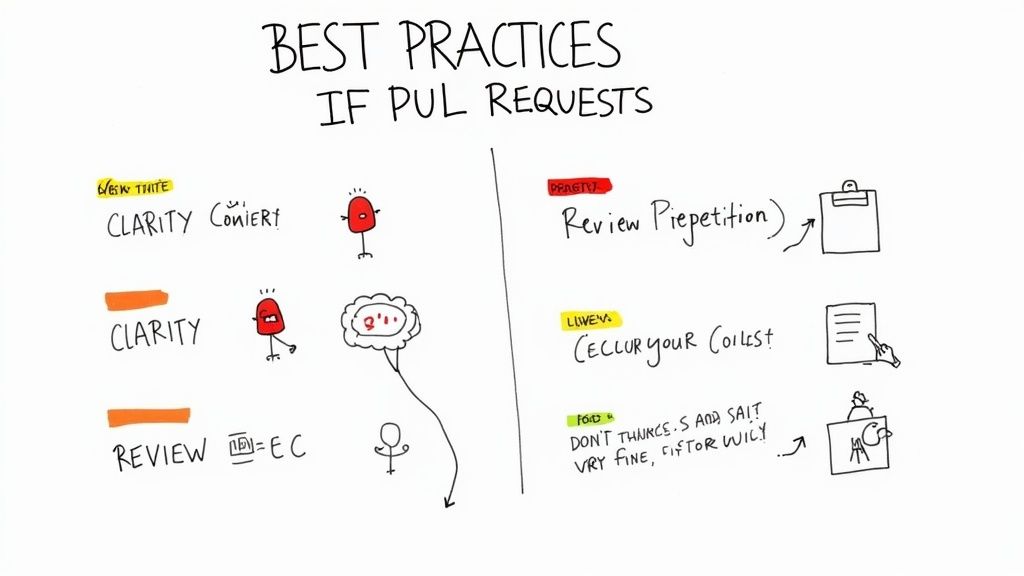
Code reviews are essential for building great software and fostering a strong engineering culture. When done well, they transform from a potential bottleneck into a powerful tool for collaboration and knowledge sharing. Let's explore practical ways to make code reviews more effective through constructive feedback, healthy technical discussions, and consistent quality standards.
Providing Constructive Feedback: The Heart of Effective Reviews
The impact of feedback depends heavily on how it's delivered. Frame suggestions positively and keep the focus on the code rather than the developer. Instead of "This code is hard to follow," try "We could improve readability by breaking this into smaller functions." Back up your suggestions with specific examples and solutions that help move the conversation forward.
Navigating Technical Disagreements: Maintaining Professionalism
Technical discussions are bound to get heated sometimes, but they're valuable chances to learn from each other. Keep conversations grounded in technical merit rather than personal preferences. Support your points with references to established patterns, documentation, or performance metrics. This helps build shared understanding and keeps discussions productive.
Maintaining Consistent Quality: Setting Clear Expectations
Clear coding standards and expectations make reviews smoother and more productive. When everyone knows what "good code" looks like upfront, there's less back-and-forth during reviews. Teams should document and share their standards, making them easily accessible to both new and experienced developers.
The Importance of Review Cycles
One key metric for measuring review effectiveness is the number of back-and-forth cycles between author and reviewer. High-performing teams average 1.1 cycles or less per review, while the industry standard is around 1.2. When cycles exceed 1.5, it often signals underlying issues with the review process. Too many cycles can break developers' focus and slow down shipping. Learn more about optimizing review cycles in Codeclimate's guide to pull request best practices.
Building a Culture of Collaborative Improvement
Code reviews should do more than catch bugs - they should help everyone grow as developers. Focus on learning opportunities, celebrate good patterns, and approach feedback as a two-way conversation. Tools like Mergify can streamline parts of the process by automating reviewer assignment and enforcing merge rules. This lets the team focus on meaningful discussions that improve code quality and help developers learn from each other.
Making Pull Request Workflows Better Through Automation
Modern PR workflows can be dramatically improved by strategically applying automation. When you combine automated tools with thoughtful human oversight, you create a system that helps teams work faster while maintaining quality standards. Here's how to effectively use automation for testing, code checks, and preview environments.
Smart Testing and Code Quality Automation
Every PR should kick off a comprehensive set of automated tests to verify the changes. This includes running unit tests, integration tests, and end-to-end tests that act as guardrails to prevent bugs from reaching production. Code quality tools add another layer of protection by checking for style issues, overly complex code, and potential security problems.
Mergify and similar tools make it easy to set up and enforce these automated checks consistently across all PRs. The key is configuring the right mix of tests and quality checks for your team's needs.
Better Reviews with Templates and Automated Checks
Well-designed PR templates guide developers to include all the key information reviewers need upfront. A good template asks for a clear description of the changes, explains the reasoning behind them, and prompts for testing details. This helps avoid back-and-forth questions later.
You can also set up automated checks that verify PRs meet specific requirements before merging. Common checks include:
- Having a minimum number of approvals
- Linking to related issues
- Staying under size limits
- Passing all required tests
These guardrails help maintain quality standards and prevent incomplete PRs from being merged accidentally.
Catching Issues Early with Deployment Previews
Taking automation further, deployment previews automatically create a staging environment for each PR. This lets the team see and test changes in a production-like setting before merging.
Preview environments are especially valuable for:
- Front-end changes that need visual verification
- Complex user interactions that are hard to test automatically
- Integration points between different parts of the system
Mergify helps teams set up and manage these preview environments as a natural part of the PR workflow. Getting early feedback this way helps catch issues that automated tests might miss.
Putting It All Together
To implement these automated workflows effectively, start by identifying where automation will help your team the most. Consider:
- Which testing frameworks fit your tech stack
- What code quality metrics matter most
- How to set up staging environments
Build your automation incrementally, measuring the impact at each step. The goal is creating a PR process that helps your team work efficiently while maintaining high quality standards.
Focus on automating repetitive checks while preserving human judgment for complex decisions. This balanced approach leads to better software delivery with less manual overhead.
Implementation Blueprint: Your Path to PR Excellence
Establishing high-quality pull request practices is a journey that takes careful planning and consistent effort. Let's explore a practical, step-by-step approach to build an effective PR process that works for your team, no matter its size or project type.
Phase 1: Establishing the Foundation
Start by creating clear guidelines and setting up essential infrastructure for your PR workflow. The right foundation helps prevent confusion and creates consistency across your team.
- Set Clear Objectives: Identify specific goals for your PR process. Are you aiming to speed up code delivery? Improve code quality? Foster better team collaboration? Having clear targets helps guide every decision.
- Select Appropriate Tools: Consider tools like Mergify to handle routine tasks like size limits and merge queues. Pick solutions that match your team's specific needs rather than adopting everything available.
- Document Standards: Create detailed coding standards and style guides. When everyone shares the same understanding of quality code, reviews become more efficient and productive.
Phase 2: Implementing Core Best Practices
Build on your foundation by putting key PR management principles into action.
- Keep PRs Focused: Encourage your team to submit smaller, single-purpose pull requests. When each PR addresses one specific issue or feature, reviews are faster and problems are easier to spot.
- Write Clear Descriptions: Make sure every PR includes details about what changed, why it changed, and how it was tested. Good context helps reviewers understand and evaluate code more effectively.
- Give Better Feedback: Show your team how to provide specific, actionable review comments that help improve the code. Build a culture where feedback is collaborative and constructive.
Phase 3: Automating Your Workflow
Smart automation makes your PR process more reliable and efficient.
- Add Testing Pipelines: Set up automated tests in your CI/CD workflow to catch problems early. Include unit tests, integration tests, and end-to-end tests for each PR.
- Enable Quality Gates: Use Mergify to enforce key requirements like minimum approvals and issue links. These automated checks provide consistent quality control.
- Create Test Environments: Build preview environments where teams can test changes before they go live. This is particularly helpful for testing UI changes and complex feature interactions.
Phase 4: Continuous Improvement
Keep refining your PR process based on real-world results and team feedback.
- Measure Performance: Keep track of important numbers like PR size, review time, and review cycles. Use this data to identify areas that need attention.
- Review and Update: Schedule regular check-ins to evaluate your PR workflow and coding standards. Listen to your team's experiences and adjust your approach accordingly.
- Stay Flexible: As your team grows and projects evolve, be ready to adapt your PR practices. Try new tools and methods that could make your workflow better.
Looking to make your code integration process smoother and more efficient? Mergify provides powerful automation tools and smart merge strategies that simplify PR management and save valuable development time. Check out Mergify to see how it can improve your team's workflow.



